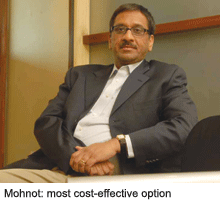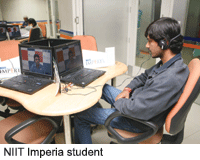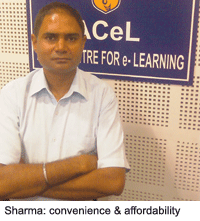Online lifeline for Indian education
With the cash-strapped Central and state governments, who run a combined fiscal deficit of 11-12 percent of GDP ill-positioned to substantially augment bricks-and-mortar education capacity in the forseeable future, online learning aka e-learning has emerged as the great white hope of Indian education. Hemalatha Raghupathi reports
.gif) With 21st century India’s ramshackle higher education system able to accommodate a mere 9 percent of its 100 million youth in the age group 18-24 (cf. 80 percent in the US and 20 percent in China), and dim prospects of the Central and state governments who run a combined fiscal deficit of 11-12 percent of GDP, substantially augmenting bricks-and-mortar education capacity in the foreseeable future, online education aka e-learning (i.e learning over the internet and/or via satellite technology) has emerged as the great white hope of Indian education. Although currently e-learning is in a nascent stage in India, hamstrung by an internet penetration rate of a mere 4 percent, it’s projected to grow in leaps and bounds in the next decade.
With 21st century India’s ramshackle higher education system able to accommodate a mere 9 percent of its 100 million youth in the age group 18-24 (cf. 80 percent in the US and 20 percent in China), and dim prospects of the Central and state governments who run a combined fiscal deficit of 11-12 percent of GDP, substantially augmenting bricks-and-mortar education capacity in the foreseeable future, online education aka e-learning (i.e learning over the internet and/or via satellite technology) has emerged as the great white hope of Indian education. Although currently e-learning is in a nascent stage in India, hamstrung by an internet penetration rate of a mere 4 percent, it’s projected to grow in leaps and bounds in the next decade.
According to Netscribes, a Kolkata-based knowledge consulting and solutions firm, the e-learning market broadly comprising ICT (instruction and communication technologies) in schools, online tutoring for K-12 students and broadcast of graduate and postgraduate study programmes, generates an aggregate revenue of Rs.1,602 crore per year. It is expected to rise almost ten-fold to Rs.11,750 crore by 2012.
Online education or delivery of high quality education via sophisticated 21st century communication technologies, is being enthusiastically embraced by a rapidly growing number of Indian youth fed up with obsolete curriculums, faculty shortages, crumbling infras-tructure and capacity constraints which characterise Indian higher education. Moreover the 9 percent of youth who scramble into India’s 431 universities and 21,000 colleges don’t necessarily acquire meaningful education.
According to a McKinsey-NASSCOM study of 2005, over 75 percent of engineering graduates stepping out of the country’s 2,240 engineering colleges, and 80 percent of arts, science and commerce college graduates are unemployable, and require intensive supplementary training before they can join the workforce. Consequently, the prospect of students in remote small towns and perhaps even villages, being able to access study programmes and lectures of best teachers over the internet or via satellite technology is exciting news for the great majority of India’s 89 million educationally under-served youth, and 2.75 million graduates who require upskilling to become employable.
 “The only way to reach acceptable quality, job-oriented education to India’s 100 million youth under 25 years of age is through technology-enabled distance learning. Since the conventional Indian education system cannot quickly scale up, and most higher education institutions are suffering severe faculty shortages, online education can be used to effectively distribute high-quality content delivered by the best faculty to millions of students countrywide. Technology-enabled distance learning is truly transformational and has the potential to radically alter the profile of Indian higher education by boosting enrolment and improving industry-readiness of graduates,” says Shailesh H. Mehta, founder chief executive of GurukulOnline Learning Solutions Pvt. Ltd (GOLS), a Mumbai-based e-learning company which offers a wide range of online study programmes to corporates and students across the country.
“The only way to reach acceptable quality, job-oriented education to India’s 100 million youth under 25 years of age is through technology-enabled distance learning. Since the conventional Indian education system cannot quickly scale up, and most higher education institutions are suffering severe faculty shortages, online education can be used to effectively distribute high-quality content delivered by the best faculty to millions of students countrywide. Technology-enabled distance learning is truly transformational and has the potential to radically alter the profile of Indian higher education by boosting enrolment and improving industry-readiness of graduates,” says Shailesh H. Mehta, founder chief executive of GurukulOnline Learning Solutions Pvt. Ltd (GOLS), a Mumbai-based e-learning company which offers a wide range of online study programmes to corporates and students across the country.
Founded in 2001, GOLS offers continuous education programmes over the internet to employees of over 20 companies, in addition to developing customised digital content for them. The company has also signed collaboration agreements with 23 reputed bricks-and-mortar education institutions to broadcast their study programmes countrywide. Among them: the Institute of Company Secretaries of India (ICSI) to provide online coaching for its foundation, intermediate and final courses/exams; Insurance Regulatory Development Authority (IRDA) for life and non-life insurance training; Retailers Association of India for its retail professional certificate programme; and Financial Planning Standards Board of India for its certified financial planner (CFP) and associate financial planner (AFP) courses.
“Student enrolment in our online study programmes has grown from 10,000 three years ago to over 100,000 currently. Next year we expect enrolment to cross 250,000. The big benefit of e-learning is that it’s highly affordable, with the cost almost 30 percent less than of regular classroom education. Moreover, contrary to popular perception, placements are also not a problem for graduates with online degrees. For instance, of the 500 certified financial planners we trained last year, 200 have been placed with blue-chip firms while the rest opted for private practice,” says Mehta.
At the start of the new millennium, when online technology for delivering study programmes was introduced in India, the first takers of this wonder service were corporates, and IT companies in particular. Given the vast gap between the inputs of Indian academia and requirements of industry, IT companies, which are obliged to spend millions on classroom-style skills and finishing programmes to make fresh graduates industry-ready, welcomed online education as a cost-effective alternative. The big plus was that it became possible for them to deliver standardised training over the internet to employees spread over multiple locations, cutting training costs significantly. Now, with the IT industry having validated online education, the banking and financial, insurance, telecom and organised retail industries have jumped on the e-learning bandwagon.
 “The Indian economy has entered a high-growth orbit and needs a large number of highly educated and skilled professionals to sustain its 6-8 percent per year GDP growth. India’s handful of highly rated education institutions can’t cater to the growing demand for quality education and hundreds of thousands of talented but poorly served graduates are being deprived of it. The dominant requirement of industry is making fresh graduates industry-ready, and for continuous executive training. And the most cost-effective way of delivering industry specific, customised training to young graduates and executives is through the online medium. Also, given that industry costs of on-the-job training are rising continuously, the e-learning market is waiting to explode,” says Navyug Mohnot, the Delhi-based chief executive officer of QAI (estb.1980), a global consulting and workforce development organisation which delivers instructor-led online learning services to corporates. Currently QAI offers over 45 online study programmes to companies for upskilling and training employees.
“The Indian economy has entered a high-growth orbit and needs a large number of highly educated and skilled professionals to sustain its 6-8 percent per year GDP growth. India’s handful of highly rated education institutions can’t cater to the growing demand for quality education and hundreds of thousands of talented but poorly served graduates are being deprived of it. The dominant requirement of industry is making fresh graduates industry-ready, and for continuous executive training. And the most cost-effective way of delivering industry specific, customised training to young graduates and executives is through the online medium. Also, given that industry costs of on-the-job training are rising continuously, the e-learning market is waiting to explode,” says Navyug Mohnot, the Delhi-based chief executive officer of QAI (estb.1980), a global consulting and workforce development organisation which delivers instructor-led online learning services to corporates. Currently QAI offers over 45 online study programmes to companies for upskilling and training employees.
The constant need for working professionals to keep pace with new technologies, products and services without disrupting fast-track careers, provided the initial impetus for the growth and popularity of online learning in India. Moreover for the country’s most highly-rated higher education institutions such as the IIMs and IITs, offering online education programmes meant that they didn’t have to recruit additional faculty and/or expand admission capacity. The technology breakthrough of online learning enabled their managements to beam lectures by star faculty and exclusively designed content, to thousands of talented students in faraway locations country-wide. For graduates and working professionals it was a winning proposition too: they could get highly-prized IIT/IIM certification without interrupting their careers. Thus over the past quinquennium engineering, finance, management, human resources, mass communications and soft skills have emerged as the most popular online certification programmes.
Comments Prof. Punam Sehgal, dean of the Noida campus of the Indian Institute of Management, Lucknow (IIM-L): “There is rising demand from working professionals for IIM certification and online study programmes as they are flexible and don’t require a career break. Last October we launched our first online 12-month general management programme for executives with minimum six years experience. More than 75 managers have signed up for this progra-mme. As in our conventional campus courses, we ensure that our online programmes are academically rigorous with students given project work and assignments. We plan to offer three more online programmes next year enroling 200-300 students per programme.”
 Currently IIM-L offers its 12-month general management programme (tuition fee: Rs.2 lakh) in collaboration with NIIT Ltd, India’s market leader ICT-driven education services behemoth (sales revenue: Rs.979.9 crore in the year ended March 31, 2009), which provides technology and marketing support. IIM-L faculty prepare the curriculum and deliver lectures from their on-campus studio to students in virtual classrooms in NIIT centres countrywide.
Currently IIM-L offers its 12-month general management programme (tuition fee: Rs.2 lakh) in collaboration with NIIT Ltd, India’s market leader ICT-driven education services behemoth (sales revenue: Rs.979.9 crore in the year ended March 31, 2009), which provides technology and marketing support. IIM-L faculty prepare the curriculum and deliver lectures from their on-campus studio to students in virtual classrooms in NIIT centres countrywide.
Given that of the 300,000 graduates who write the CAT (Common Admission Test) for entry into the country’s seven IIMs every year, a mere 1,800 are admitted, the NIIT top brass discerned a great business opportunity in providing IIM education to the 1 million next-best aspirational graduates, who had to make do with second best B-school education. Therefore in 2006, they persuaded several front-rank B-schools to partner with the company and deliver synchronous online distance learning MBA programmes to working professionals. They signed up with six highly-fancied B-schools — IIM-Ahmedabad, Calcutta, Lucknow, Indore; IIFT-Delhi and IMT-Ghaziabad — to promote its NIIT Imperia division which offers refresher courses and upskilling programmes to mid-level and senior executives in Indian industry.
.gif) Under the arrangement with the six highly-rated B-schools (enumerated above), business management education is jointly provided by the company and partner B-schools in 22 fully-wired interactive NIIT centres countrywide, with working professionals lectured through broadcasts of the best faculty of partner B-schools. “We have designed 25 two-year executive MBA programmes (price: Rs.50,000-70,000 per year) for professionals with 0-3 years, 6-10 and 10 years-plus experience, and have trained and upskilled 1,800 executives — certified by our partner B-schools — thus far. In the next three years the number will increase to over 10,000,” says Dr. Smarjit Dey, an alum and former professor of BITS, Pilani and currently president of NIIT Imperia.
Under the arrangement with the six highly-rated B-schools (enumerated above), business management education is jointly provided by the company and partner B-schools in 22 fully-wired interactive NIIT centres countrywide, with working professionals lectured through broadcasts of the best faculty of partner B-schools. “We have designed 25 two-year executive MBA programmes (price: Rs.50,000-70,000 per year) for professionals with 0-3 years, 6-10 and 10 years-plus experience, and have trained and upskilled 1,800 executives — certified by our partner B-schools — thus far. In the next three years the number will increase to over 10,000,” says Dr. Smarjit Dey, an alum and former professor of BITS, Pilani and currently president of NIIT Imperia.
While online certification has definitely helped Indian industry cut training costs, and working professi-onals boost their resumés and job prospects, full-time undergrad and postgrad students in engineering colleges are also turning to web-based learning to supplement classroom teaching-learning. India’s 2,240 engineering colleges are under fire from industry for dispensing poor-quality education, and are suffering acute faculty shortages and capacity cons-traints. According to a NASSCOM-Mckinsey study of 2005, only 25 percent of the 495,000 engineering graduates churned out annually are industry ready and employable.
Therefore to enhance the quality of engineering education and make high-quality course materials and lectures from qualified professors in prestigious institutes available to the 2.5 million students enroled in the country’s faltering engineering colleges, seven Indian Institutes of Technology (IITs) and the Indian Institute of Science (IISc), Bangalore, jointly launched the National Programme on Technology Enhanced Learning (NPTEL) in Sept-ember 2006. This initiative involves creating web and video content for undergraduate and postgrad science and engineering study programmes in two phases.
Funded by the Union human resource development ministry, Phase 1 of NPTEL was rolled out last year, and currently 125 internet-based courses are available on the NPTEL website (www.nptel.com) while 110 video lectures are regularly broadcast on the television channel DD Ekalavya, and are also made available on YouTube (www.youtube.com/iit). When the second phase of the initiative is completed in 2012, it will be the largest video repository of technical lecture courses worldwide.
 “The existing 3,500 faculty in the seven IITs is insufficient to meet the learning requirements of India’s 2.5 million engineering students. Now with NPTEL operational, high-quality content can be accessed by thousands of students in smaller engineering colleges spread across the country,” says Dr. Mangala Sunder Krishnan, professor of chemistry at IIT-Madras, and national coordinator for NPTEL’s web-based engineering study programmes.
“The existing 3,500 faculty in the seven IITs is insufficient to meet the learning requirements of India’s 2.5 million engineering students. Now with NPTEL operational, high-quality content can be accessed by thousands of students in smaller engineering colleges spread across the country,” says Dr. Mangala Sunder Krishnan, professor of chemistry at IIT-Madras, and national coordinator for NPTEL’s web-based engineering study programmes.
Encouraged by the success of NPTEL, in February 2007 the Union HRD ministry launched a similar initiative for upgrading education dispensed in India’s 18,000 arts, science and commerce colleges. The centrally-sponsored National Mission on Education (NME) also banks on new internet technologies to upgrade the quality of teaching/learning in India’s higher education institutions. The government has earmarked Rs.4,612 crore for the project during the Eleventh Plan period (2007-2012). The two thrust areas of NME will be to provide personalised and interactive knowledge modules over the internet/intranet to undergraduate students countrywide, and equip every college and university in the country with broadband connectivity.
To realise the promise of online education as a panacea to India’s higher education deficiencies, the University Grants Commission has also set up UGC-Infonet with the objective of interlinking the country’s 431 universities through the internet, enabling faculty and students to exchange high-quality education materials and journals. Moreover the Central-government owned and administered Indira Gandhi National Open University (IGNOU) — India’s largest distance education provider which pioneered virtual campus study programmes in 1999 — has expanded the reach of its online programmes to cover 500,000 students enroled in 1,100 courses.
Although UGC Infonet and IGNOU were established at considerable cost to the government exchequer in 2002 and 1985 respectively, the former has morphed into an administrators’ site in which the 150 universities which have linked up with UGC, exchange information about the administrative and funding procedures of UGC. On the other hand, IGNOU has acquired a good reputation for the quality of study materials it transmits online and for its postgrad vocational courses for working professionals. “IGNOU made a good start when it was launched a decade ago, but it hasn’t quite lived up to its promise. But this may be due to limited internet and broadband connectivity in India,” says Dr. M.D. Usha Devi, professor and head of the centre for human resource development at the Institute of Social and Economic Change, Bangalore.
Unlike government-run online institutions and organisations, which tend to offer too diverse a range of study programmes, private sector institutions offering a limited range of subjects, and particularly business management education, quickly acquire good reputations. A case in point is the Delhi-based private sector Amity University (estb.2003), which in partnership with the Mumbai-based Gurukul Online Learning Solutions has been offering graduate and postgraduate diploma programmes in business management since 2006, to almost 1,000 students in 45 countries around the world.
 “Online learning fulfils our philosophy of ‘taking Amity to the world and bringing the world to Amity’. It eliminates the deficiencies of the traditional distance learning model and facilitates students around the world to acquire quality education from highly-qualified faculty at their convenience at affordable prices. Most of our students are working professionals who sign up to upgrade their knowledge and skill-sets. We plan to shortly introduce several new job-oriented degree and short-term courses, and in the long term our efforts will be directed towards transforming into a virtual university,” says Manoj S. Sharma, the Delhi-based deputy director (e-learning programmes) of the Pan African e-Network Project of the Amity Centre for e-learning.
“Online learning fulfils our philosophy of ‘taking Amity to the world and bringing the world to Amity’. It eliminates the deficiencies of the traditional distance learning model and facilitates students around the world to acquire quality education from highly-qualified faculty at their convenience at affordable prices. Most of our students are working professionals who sign up to upgrade their knowledge and skill-sets. We plan to shortly introduce several new job-oriented degree and short-term courses, and in the long term our efforts will be directed towards transforming into a virtual university,” says Manoj S. Sharma, the Delhi-based deputy director (e-learning programmes) of the Pan African e-Network Project of the Amity Centre for e-learning.
Although the entry of highly-respected higher education institutions such as IGNOU, IITs, IISc, IIMs and Amity into the web-based learning services sector has lent credibility and respect to online education, it’s important to note that they offer supplementary education and/or add-on certification for working professionals and graduates keen on updating their knowledge and skills. Consequently it’s mature students who tend to sign up for online education programmes. Within the 100-million younger 18-24 age group there is considerable resistance to fully online degree programmes.
To address the apprehensions of students suspicious of the quality and marketability of online certification, the Manipal Education Group (MEG), India’s largest provider of professional (engineering, medical, business management, pharmacoepial, nursing, etc) education, has pioneered a hybrid distance learning model combining traditional classroom instruction with online learning. Its Sikkim Manipal University, Gangtok (SMU, estb. 2001) offers over 40 study programmes at the undergraduate, postgrad, and diploma levels to 255,000 students who attend classes in 610 fully-wired SMU learning centres across the country. In these learning centres, registered students receive lectures and interactive instruction beamed via satellite technology from specially-equipped studios of SMU. On completion of their programmes, students are awarded degrees and/or certification by SMU.
.gif) “Given that India has a long-established tradition of learning in classroom environments, distance education is best delivered in the hybrid mode, which combines the reach of new communication technologies with classroom-style learning. Online education cannot be a replacement of conventional education. The hybrid model is ideal for the Indian education system as it enables education delivery in familiar classroom environments while maximising teacher reach and productivity. I believe our new EduNxt system is the best answer to the education needs of India’s 89 million under-served youth,” says Anand Sudarshan, chief executive of MEG.
“Given that India has a long-established tradition of learning in classroom environments, distance education is best delivered in the hybrid mode, which combines the reach of new communication technologies with classroom-style learning. Online education cannot be a replacement of conventional education. The hybrid model is ideal for the Indian education system as it enables education delivery in familiar classroom environments while maximising teacher reach and productivity. I believe our new EduNxt system is the best answer to the education needs of India’s 89 million under-served youth,” says Anand Sudarshan, chief executive of MEG.
The comfort level of Indian students with hybrid online education has also prompted top-ranked foreign universities to partner with bricks-and-mortar Indian education institutions to enable them to enhance the quality of their study programmes. For instance in 2007, Carnegie Mellon University, USA tied up with the Chennai-based Shri Sivasubramaniya Nadar (SSN) School of Advanced Software Engineering to offer its 18-month Master of science in information technology (MSIT) residential programme in the hybrid distance learning mode. “We have invested Rs.3 crore in our fully wi-fi enabled, 250-acre campus, and in association with Carnegie Mellon have introduced blended learning, which is a mix of traditional classroom teaching and online learning. Our 3,000 students enroled in engineering and management education access the best course materials delivered by the Carnegie faculty in familiar classroom set-ups,” says Dr. Shashikant Albal, director, SSN School of Advanced Software Engineering.
Though the nascent online revolution has expanded the higher education system and democratised access to high-quality education, it hasn’t yet attained mass popularity. Low internet penetra-tion, paucity of digitalised course content, unreliable communication infrastructure and long gestation periods for implementation, are among the factors that have restricted the country’s online/hybrid mode learners to a mere 1 million. Perhaps the biggest hurdle is low broadband penetration — high-speed broadband connectivity is a precon-dition to uninterrupted delivery of education over the internet. Currently only 1 percent (10 million) of the Indian population has access to high-speed broadband connectivity, while another 4 percent (42 million) has access to slow-speed dial-up internet connectivity.
.gif) However, with incrementally greater availability of affordable broadband connectivity options from corporates such as BSNL, Airtel and Reliance, there is a slow but definite increase in the number of online learners. Meanwhile some innovative ICT education service providers are turning to other distance learning delivery options such as satellite technology. A case in point is the Chennai-based Everonn Systems Ltd (sales revenue: Rs.121.38 crore in the year ended March 2009), which has pioneered digital content for the school and higher education sectors through hi-tech, very small aperture terminal (Vsat) technology. High-quality content is beamed using Vsat technology from the company’s studios to learning centres in 333 schools and 362 colleges countrywide.
However, with incrementally greater availability of affordable broadband connectivity options from corporates such as BSNL, Airtel and Reliance, there is a slow but definite increase in the number of online learners. Meanwhile some innovative ICT education service providers are turning to other distance learning delivery options such as satellite technology. A case in point is the Chennai-based Everonn Systems Ltd (sales revenue: Rs.121.38 crore in the year ended March 2009), which has pioneered digital content for the school and higher education sectors through hi-tech, very small aperture terminal (Vsat) technology. High-quality content is beamed using Vsat technology from the company’s studios to learning centres in 333 schools and 362 colleges countrywide.

Unavailability of broadband connectivity apart, another factor impeding the growth of online education in India is the uncertainty over industry recognition of online against traditional degrees. “I don’t believe there’s a bias in industry against online degrees. On the contrary it’s the preference of Indian students for classroom learning which makes them hesitant to enrol in online programmes, where disciplined self-study is crucial to success. Only through technology innovations can quality education reach the huge mass of under-served children and youth in India. The Central government and private sector must collaborate and complement each other’s efforts in raising online distance education to the next level. That’s the way forward if India wants to expand higher education access and overcome the crippling shortage of teachers at the school and university levels,” says Krishnan Ganesh, founder and CEO, TutorVista Global Ltd, the pioneer online tutoring company which provides coaching in math, English and science to 10,000 students worldwide.
Fortuitously for Indian education, the reform-oriented Kapil Sibal has taken charge of the Union HRD ministry and is making encouraging noises about harnessing the full power of ICT-enabled technologies to reach quality education to under-served students countrywide. In the minister’s ambitious 100-day plan announced on June 25, there’s a commitment to formulate a new enabling policy for distance education and immediately wire up 5,000 colleges/university departments with broadband connectivity. This national awareness, combined with the mushrooming of online private education providers, offers the exciting prospect of educating and upskilling India’s 100 million under-served youth to compete in a rapidly globalising world.
With Vidya Pandit (Lucknow); Harshikaa Udasi (Mumbai); Deoblina Sengupta & Summiya Yasmeen (Bangalore)














Add comment